Southerndown Coast
Southerndown Coast is a Site of Special Scientific Interest (SSSI) in St Brides Major community, in the Vale of Glamorgan, South Wales. It forms part of the Glamorgan Heritage Coast, bordered by the Monknash Coast to the southeast. The nearby villages are Southerndown and Ogmore-by-Sea. The SSSI extends over 5 kilometres (3 miles) of south-west facing coastline, with rocky limestone cliffs, broad beaches and deeply fissured wave-cut platforms.[1]
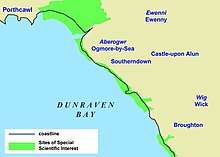
Southerndown Coast SSSI
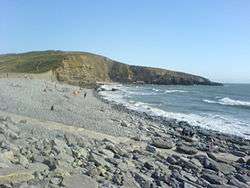

The 153 hectares (380 acres) stretch of shore, cliff, cliff-top, and several short, steep valleys, are designated an SSSI both for their geology and botanical value.[2] The cliffs expose the local Jurassic geological strata and some of the underlying Carboniferous Limestone, the latter dating from between 359 to c. 330 million years ago. By the Triassic period, 200 million years ago, the Carboniferous rocks had already been tilted and eroded.[2] A new deposition phase created more sedimentary rocks, including a red Triassic conglomerate, and a creamy white Jurassic limestone known as Sutton Stone, a freestone much sought-after for carved stonework, and so widely quarried where it occurs.[1] The SSSI is in two parts. The northern section is the wave-cut platform alongside Ogmore-by-Sea. The southern section, with a short gap, covers both the intertidal areas and the cliffs and grassy cliff-tops of Dunraven Bay, Trwyn y Witch headland and the valleys and shoreline of Cwm Mawr and Cwm Bach.[2] The whole length of the SSSI is traversed by the South Wales section of the Wales Coast Path.[3]
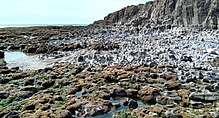
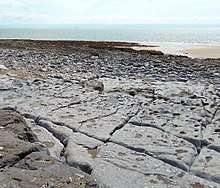
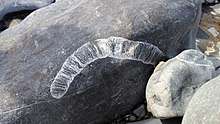

Geology
Geological SSSIs are selected to protect sites that display one or more definitive geological features. Three geological features are noted for this site as being of particular significance:–
- Alluvial fan deposits of Triassic sediments where they were deposited onto the eroded Carboniferous Limestone surface.
- Jurassic intrusion of mineralised fluids into the basal breccia, Carboniferous limestone and Triassic rocks. Veins of calcite, baryte and galena are found within the coastal cliffs and outcrops.
- The gradual change in deposition characteristics from water's edge (littoral) deposits through to the deeper water marine deposits can be seen south-east of Black Rocks. The cliffs and foreshore show this transition better than anywhere in Britain,[4]
Places to look for these different geological features include:-
- Triassic/Carboniferous unconformity and fan deposit: 51.463691°N 3.6409129°W, SS8610675135.[5]
- Fossils in the limestone pavement: 51.458959°N 3.6352732°W, SS8648674600.[5]
- The Carboniferous unconformity, karstic fill and mineralised veins: 51.458336°N 3.6341714°W, SS8656174529.[5]
- Triassic conglomerates show well at51.457555°N 3.6333806°W, SS8661474441.[5]
- A former quarry and lead mine: 51.456138°N 3.6290435°W, SS8691274277.[1]
- Deep fissures in the Limestone pavement create blowholes. Overlying this are layers of Sutton Stone outcrops, and thinner banded limestone of the Southerndown beds: 51.454782°N 3.6265035°W, SS8708574122.[1]
Botany
The cliff-top grassland is species-rich, with a range of different plant communities. Where the limestone is at the surface, calcareous wildflowers are abundant, notably quaking grass, rock-rose and wild thyme. Other localities have neutral, deeper soil and cowslips, dog-violets and bird's foot trefoil are common. Nearer the sea, salt spray gives a maritime grassland community, including red fescue, sea carrot and buck's-horn plantain.[4]
See also
- List of Sites of Special Scientific Interest in Mid & South Glamorgan
- Old Castle Down (Neighbouring SSSI)
References
- Howe, S.R. (March 1996). "Geological Walks in Wales: Ogmore-by-Sea" (PDF). www.swga.org.uk. South Wales Geologists' Association. Retrieved 5 November 2013.
- www.ccgc.gov.uk sssi sites: southerndown coast Archived 2013-11-09 at the Wayback Machine accessed 5 November 2013
- Wales Coast Path: South Wales Coast and Severn Estuary Accessed 10 November 2013
- link to Southerndown Coast SSSI citation sheet, first cited, 1965 Archived 2013-11-09 at the Wayback Machine. Countryside Council for Wales. Accessed 7 November 2013.
- The Unofficial Ogmore-by-Sea Geological Website Accessed 5 November 2013